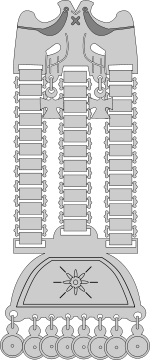Mapuche silverwork

Mapuche silverwork is one of the best known aspects of Mapuche material culture.[1] The adornments have been subject to changes in fashion but some designs have resisted change.
History
In the later half of the 18th century, Mapuche silversmiths began to produce large amounts of silver finery.[2] The surge of silversmithing activity may be related to the 1641 parliament of Quillín and the 1726 parliament of Negrete that decreased hostilities between Spaniards and Mapuches and allowed trade to increase between colonial Chile and the free Mapuches.[2][3] In this context of increasing trade, Mapuches began in the late 18th century to accept payments in silver coins for their products; usually cattle or horses.[2] These coins and silver coins obtained in political negotiations served as raw material for Mapuche metalsmiths (Mapudungun: rüxafe).[2][3][4] Old Mapuche silver pendants often included unmelted silver coins, something that has helped modern researchers to date the objects.[4] The bulk of the Spanish silver coins originated from mining in Potosí in Upper Peru.[3]
The great diversity in silver finery designs is indebted to the fact that designs were done to be identified with different reynma (families), lof mapu (lands) as well as specific lonkos and machis.[5] Mapuche silver finery was also subject to changes in fashion albeit designs associated with philosophical and spiritual concepts have not undergone major changes.[5]
In late 18th century and early 19th century, Mapuche silversmithing activity and artistic diversity reached it climax.[6] All important Mapuche chiefs of the 19th century are supposed to have had at least one silversmith.[2] The 1869 war between Chile and independent Mapuches provoked a famine among Mapuches in the winter of 1869, with the situation being worsened by a smallpox epidemic.[7] This situation led some Mapuches to sell their silver adornments in the towns of La Frontera to obtain food.[7]
As of 1984, Mapuche scholar Carlos Aldunate noted that there were no silversmiths alive among contemporary Mapuches.[2]
Appearance
Although these adornments showed some variation in form, the principal one appears to be a set of three separate columns of flattened silver links joined to each other by square alternating links. At the top of the set of columns, and holding them together, is a flat two-headed bird figure and at the base is a flat semicircle or trapezoid that usually has a series of small disks dangling from its base. The wearer would place the object hanging from his/ her neck and down the chest.
Notes
- ↑ Painecura 2011, p. 15.
- 1 2 3 4 5 6 Aldunate, Carlos (1984). "Refrexiones acerca de la platería mapuche" (PDF). Cultura-Hombre-Sociedad. 1. Retrieved 13 November 2013.
- 1 2 3 Painecura 2011, pp. 25-26.
- 1 2 Kangiser Gómez, María Fernanda (2002). "Conservación en platería mapuche: Museo Fonck, Viña del Mar" (PDF). Conserva. 6. Retrieved 13 November 2013.
- 1 2 Painecura 2011, pp. 27-28.
- ↑ Painecura 2011, p. 30.
- 1 2 Bengoa 2000, p. 224.
References
- Bengoa, José (2000). Historia del pueblo mapuche: Siglos XIX y XX (Seventh ed.). LOM Ediciones. ISBN 956-282-232-X.
- Painecura Antinao, Juan (2011). Charu. Sociedad y cosmovisión en la platería mapuche.
External links
- Mapuche silverwork, collection of the National Museum of the American Indian
